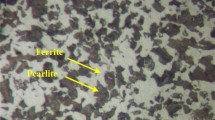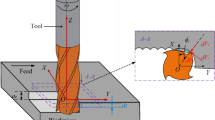Abstract
Cutting residual stresses (stresses that result after cutting a material) of a machined layer has a direct relationship with machined surface quality. The condition of a machined surface is affected by several factors, including tool and workpiece materials, cutting parameters (cutting speed, feed rate, and depth of cut), and contact conditions at the tool/workpiece interface. This paper presents the effects of machined surface quality and cutting parameters on residual stress distribution. The cutting residual stress of 7075 aluminum alloy is experimentally and numerically investigated by an X-ray diffraction technique and an elastic-viscoplastic FEM formulation. The results show that cutting residual stresses increase with machined surface roughness. Among other cutting conditions, main spindle rotational speed, feed speed, and tool condition have a strong influence on surface residual stresses.
Similar content being viewed by others
References
Schultz, R. and Karabin, M., “Characterization of Machining Distortion by Strain Energy Density and Stress Range,” Proc. of Sixth European Conference on Residual Stresses, Vol. 404–407, pp. 61–68, 2002.
Issa, M., Saanouni, K., Labergere, C., and Rassineux, A., “Prediction of Serrated Chip Formation in Orthogonal Metal Cutting by Advanced Adaptive 2D Numerical Methodology,” International Journal of Machining and Machinability of Materials, Vol. 9, No. 3, pp. 295–315, 2011.
Saanouni, K., Lestriez, P., and Labergère, C., “2D Adaptive FE Simulations in Finite Thermo-Elasto-Viscoplasticity with Ductile Damage: Application to Orthogonal Metal Cutting by Chip Formation and Breaking,” International Journal of Damage Mechanics, Vol. 20, No. 1, pp. 23–61, 2011.
Lin, Z. C., Lai, W. L., Lin, H., and Liu, C., “The Study of Ultra-Precision Machining and Residual Stress for NiP Alloy with Different Cutting Speeds and Depth of Cut,” Journal of Materials Processing Technology, Vol. 97, No. 1, pp. 200–210, 2000.
Lin, Z. C. and Lo, S. P., “A Study of Deformation of the Machined Workpiece and Tool Under Different Low Cutting Velocities with an Elastic Cutting Tool,” International Journal of Mechanical Sciences, Vol. 40, No. 7, pp. 663–681, 1998.
Maranhão, C. and Paulo Davim, J., “Finite Element Modelling of Machining of AISI 316 Steel: Numerical Simulation and Experimental Validation,” Simulation Modelling Practice and Theory, Vol. 18, No. 2, pp. 139–156, 2010.
Yang, X. and Liu, C. R., “A New Stress-based Model of Friction Behavior in Machining and its Significant Impact on Residual Stresses Computed by Finite Element Method,” International Journal of Mechanical Sciences, Vol. 44, No. 4, pp. 703–723, 2002.
Movahhedy, M., Gadala, M. S., and Altintas, Y., “Simulation of the Orthogonal Metal Cutting Process using an Arbitrary Lagrangian-Eulerian Finite-Element Method,” Journal of Materials Processing Technology, Vol. 103, No. 2, pp. 267–275, 2000.
Nasr, M. N., Ng, E. G., and Elbestawi, M., “Modelling the Effects of Tool-Edge Radius on Residual Stresses when Orthogonal Cutting AISI 316L,” International Journal of Machine Tools and Manufacture, Vol. 47, No. 2, pp. 401–411, 2007.
Muñoz-Sánchez, A., Canteli, J., Cantero, J., and Miguélez, M., “Numerical Analysis of the Tool Wear Effect in the Machining Induced Residual Stresses,” Simulation Modelling Practice and Theory, Vol. 19, No. 2, pp. 872–886, 2011.
Movahhedy, M., Altintas, Y., and Gadala, M., “Numerical Analysis of Metal Cutting with Chamfered and Blunt Tools,” Journal of Manufacturing Science and Engineering, Vol. 124, No. 2, pp. 178–188, 2002.
Mohammadpour, M., Razfar, M., and Jalili Saffar, R., “Numerical Investigating the Effect of Machining Parameters on Residual Stresses in Orthogonal Cutting,” Simulation Modelling Practice and Theory, Vol. 18, No. 3, pp. 378–389, 2010.
Hua, J., Umbrello, D., and Shivpuri, R., “Investigation of Cutting Conditions and Cutting Edge Preparations for Enhanced Compressive Subsurface Residual Stress in the Hard Turning of Bearing Steel,” Journal of Materials Processing Technology, Vol. 171, No. 2, pp. 180–187, 2006.
Jaspers, S. and Dautzenberg, J. H., “Material Behaviour in Conditions Similar to Metal Cutting: Flow Stress in the Primary Shear Zone,” Journal of Materials Processing Technology, Vol. 122, No. 2, pp. 322–330, 2002.
Outeiro, J. C., Pina, J. C., M'saoubi, R., Pusavec, F., and Jawahir, I., “Analysis of Residual Stresses Induced by Dry Turning of Difficultto-Machine Materials,” CIRP Annals-Manufacturing Technology, Vol. 57, No. 1, pp. 77–80, 2008.
Outeiro, J. C., Umbrello, D., and M’saoubi, R., “Experimental and Numerical Modelling of the Residual Stresses Induced in Orthogonal Cutting of AISI 316L Steel,” International Journal of Machine Tools and Manufacture, Vol. 46, No. 14, pp. 1786–1794, 2006.
Rao, B., Dandekar, C. R., and Shin, Y. C., “An Experimental and Numerical Study on the Face Milling of Ti-6Al-4V Alloy: Tool Performance and Surface Integrity,” Journal of Materials Processing Technology, Vol. 211, No. 2, pp. 294–304, 2011.
Guo, Y. B. and Yen, D. W., “A FEM Study on Mechanisms of Discontinuous Chip Formation in Hard Machining,” Journal of Materials Processing Technology, Vol. 155, pp. 1350–1356, 2004.
Lee, W. S., Sue, W. C., Lin, C. F., and Wu, C.-J., “The Strain Rate and Temperature Dependence of the Dynamic Impact Properties of 7075 Aluminum Alloy,” Journal of Materials Processing Technology, Vol. 100, No. 1, pp. 116–122, 2000.
Noyan, I. C. and Cohen, J. B., “Residual Stress: Measurement by Diffraction and Interpretation,” Springer, pp. 20–30, 1987.
M’saoubi, R., Outeiro, J., Changeux, B., Lebrun, J., and Morao Dias, A., “Residual Stress Analysis in Orthogonal Machining of Standard and Resulfurized AISI 316L Steels,” Journal of Materials Processing Technology, Vol. 96, No. 1, pp. 225–233, 1999.
Author information
Authors and Affiliations
Corresponding author
Rights and permissions
About this article
Cite this article
Wu, Q., Li, DP. Analysis and X-ray measurements of cutting residual stresses in 7075 aluminum alloy in high speed machining. Int. J. Precis. Eng. Manuf. 15, 1499–1506 (2014). https://doi.org/10.1007/s12541-014-0497-4
Received:
Revised:
Accepted:
Published:
Issue Date:
DOI: https://doi.org/10.1007/s12541-014-0497-4




